#tristan and lancelot: a tale of two knights
Explore tagged Tumblr posts
Text


The birthday shenanigans started yesterday, with a nice family dinner out and presents, and continued today (mine & my mom’s actual birthday, yes we have the same one! 😊) with birthday treats! We decided to have pastries instead of a cake or cupcakes this year. I also made some brownies! 😊
My birthday haul:
My Noisy Roommate vol 1
The Feast Makers
A Tale Of Two Knights
Mr. Villain’s Day Off vol 3
A Spell For Heartsickness
Lore Olympus vol 4
The Bakery Dragon
A bunch of bookish pins
A new bookish t-shirt
An Uncle Iroh pop!
Thank you all for the wonderful gifts and birthday wishes! 😊
#booklr#birthday haul#book haul#books and treats#food#reading#books#read#book#bookish#bookworm#lgbtq+ books#queer books#my noisy roommate: the roof over my head comes with monsters and a hottie#the feast makers#the scapegracers#Tristan and Lancelot: A Tale of two knights#mr villain's day off#a spell for heartsickness#lore olympus#the bakery dragon#manga#graphic novels#cw food#tw food
22 notes
·
View notes
Text

When you imagine you and your crush as cute little hedgehogs
#this graphic novel was really nice!#i highly recommend it if you want something pretty tame and cute!#tristan and lancelot: a tale of two knights#blorbo posting#mlm#gay love#graphic novel#yaoi
5 notes
·
View notes
Text
February 2025 Reading Wrap-Up!

Read 5 Books
Sons of Darkness
The Last Bloodcarver
Tristan & Lancelot: A Tale of Two Knights
Why Don't You Eat Me, My Dear Wolf?
Can't Spell treason Without Tea
Favorite Book:
The Last Bloodcarver
Least Favorite Book:
Sons of Darkness
#books#bookblr#bookish#bookworm#book lover#book wrap#book wrap up#reading wrap up#book recs#book list#sons of darkness#gourav mohanty#the last bloodcarver#vanessa le#tristan and lancelot: a tale of two knights#james persichetti#why dont you eat me my dear wolf#ao koishikawa#cant spell treason without tea#agayprincereads
0 notes
Text
Beginner’s Guide to Medieval Arthuriana
Just starting out at a loss for where to begin?
Here’s a guide for introductory Medieval texts and informational resources ordered from most newbie friendly to complex. Guidebooks and encyclopedias are listed last.
All PDFs link to my Google drive and can be found on my blog. This post will be updated as needed.
Pre-Existing Resources
Hi-Lo Arthuriana
Medieval Literature by Language
Retellings by Date
Films by Date
TV Shows by Date
Documentaries by Date
@arthurianpreservationproject
If this guide was helpful for you, please consider supporting me on Ko-Fi!
Medieval Literature

Page (No Knowledge Required)
The Vulgate Cycle | Navigation Guide | Vulgate Reader (French)
The Wedding of Sir Gawain and Dame Ragnelle (Middle English)
The Marriage of Sir Gawain (Middle English)
Sir Gawain and The Green Knight (Middle English)
Sir Lanval (French) | Sir Launfal (Middle English)
The Welsh Triads (Welsh)
Le Morte d'Arthur by Sir Thomas Malory (Middle English)
Squire (Base Knowledge Recommended)
Owain (Welsh) | Yvain (French) | Iwein (German) | Ywain (Middle English) | Íven (Norse)
Geraint (Welsh) | Erec (French)| Erec (German) | Erex (Norse)
King Artus (Hebrew)
Morien (Dutch)
Knight (Extensive Knowledge Recommended)
The History of The King's of Britain by Geoffrey of Monmouth (Latin)
Alliterative Morte Arthure (Middle English)
The Marvels of Rigomer (French)
Jaufre (Occitan/Tagalog)
Le Bel Inconnu (French) | Gliglois (French) | Wigalois (German) | Vidvilt (Yiddish) | Sir Libeaus Desconus (Middle English) | Carduino (Italian)
Here Be Dragons (Weird or Arthurian Adjacent)
The Crop-Eared Dog (Irish)
Perceforest | A Perceforest Reader (French)
Le Roman de Silence (French)
Grail Quest
Peredur (Welsh) | Perceval + Continuations (French) | Parzival (German) | Parceval (Norse)
The Crown by Heinrich von dem Türlin (Diu Crône) (German)
The High Book of The Grail (Perlesvaus) (French)
The History of The Holy Grail (Vulgate) (French)
The Quest for the Holy Grail (Vulgate) (French)
The Quest for The Holy Grail (Post-Vulgate) (French)
Merlin and The Grail by Robert de Boron (French)
The Legend of The Grail (French)
Lancelot Texts
Knight of The Cart by Chrétien de Troyes (French)
Lanzelet by Ulrich von Zatzikhoven (German)
Spanish Lancelot Ballads (Spanish)
The Lancelot Compilation (Dutch)
Gawain Texts
Sir Gawain and The Green Knight (Middle English)
The Wedding of Sir Gawain and Dame Ragnelle (Middle English)
Sir Gawain Eleven Romances and Tales (Middle English)
Sir Gawain and The Lady of Lys (French)
The Knight of The Two Swords (French)
The Turk and Sir Gawain (Middle English)
Perilous Graveyard (French)
Roman van Walewein (Dutch)
De Ortu Waluuanii (Latin)
Valvens Þáttr (Norse)
Tristan/Isolde Texts
Béroul & Les Folies (French)
The Romance of Tristan (Prose Tristan) (French)
Tristan and The Round Table (La Tavola Ritonda) | Italian Name Guide (Italian)
Tristano Panciatichiano (Italian)
Tristano Riccardiano (Italian)
Tristan and Iseult by Gottfried von Strassburg (German)
Byelorussian Tristan (Russian)
The Tristan Legend (Norse)
Educational/Informational Resources
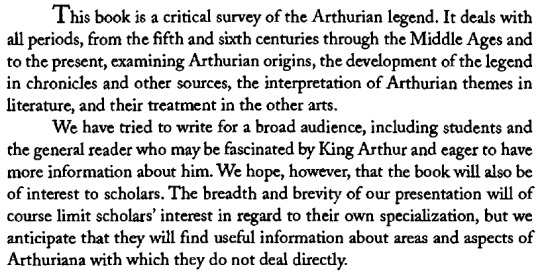
Encyclopedias & Handbooks
The Arthurian Companion by Phyllis Ann Karr
The New Arthurian Encyclopedia by Norris J. Lacy
The Arthurian Handbook by Norris J. Lacy & Geoffrey Ashe
The Arthurian Name Dictionary by Christopher W. Bruce
The King Who Was and Will Be by Kevin Crossley-Holland
Warriors of Arthur by John Matthews, Bob Stewart, & Richard Hook
Essays & Guides
A Companion to Chrétien de Troyes edited by Joan Tasker & Norris J. Lacy
A Companion to Malory edited by Elizabeth Archibald
A Companion to The Lancelot-Grail Cycle edited by Carol Dover
A Companion to the Gawain-Poet edited by Derek Brewer
Arthur in Welsh Medieval Literature by O. J. Padel
Diu Crône and The Medieval Arthurian Cycle by Neil Thomas
Wirnt von Gravenberg's Wigalois: Intertextuality & Interpretation by Neil Thomas
The Legend of Sir Lancelot du Lac by Jessie Weston
The Legend of Sir Gawain by Jessie Weston
#arthuriana#arthurian legend#arthurian mythology#arthurian literature#king arthur#queen guinevere#sir gawain#sir lancelot#sir perceval#sir percival#sir galahad#sir tristan#queen isolde#history#resource#my post
2K notes
·
View notes
Text
arthurian cinema: a vibe collection
my rule of thumb when it comes to watching movies is "must a movie be 'good'? is it not enough for it to have a bit of a weird/trippy/artsy/horny/allegorical/gay vibe?" and thank god for that because arthurian cinema has this sort of vibe in spades! so here's an assortment of some arthurian films i've seen + a reason or two why they passed my nebulous yet specific vibe check:
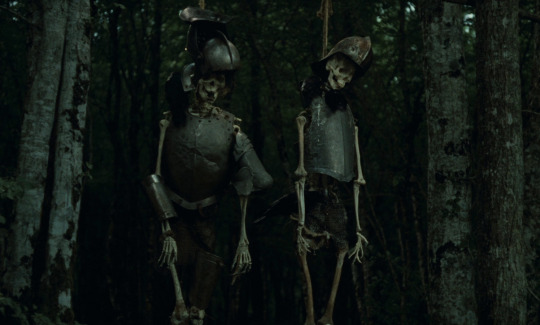
lancelot du lac 1974 is my #1 forever for the doomed repressed symbolism-soaked post-grail pre-camlann so-rigid-it's-camp atmosphere and the interpersonal dynamics between lancelot guinevere and gauvain the likes of which i haven't seen anywhere else outside of the texts

tristan et iseult 1972 is really just avant-garde performance art + the surviving copy is really rank which adds a je ne sais quoi... and congrats to tristan on his top surgery!
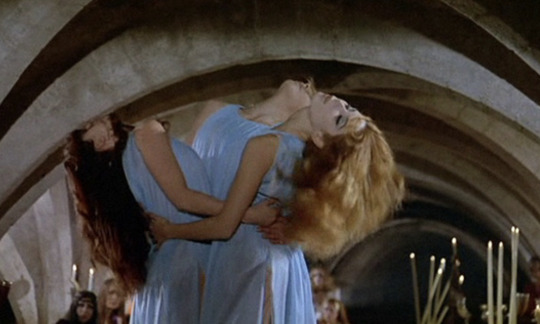
morgane et ses nymphes for the "my lesbian roadtrip led me to morgan le fay's realm and now she's obsessed with me" plot and the dreamy hazy eurotrash energies
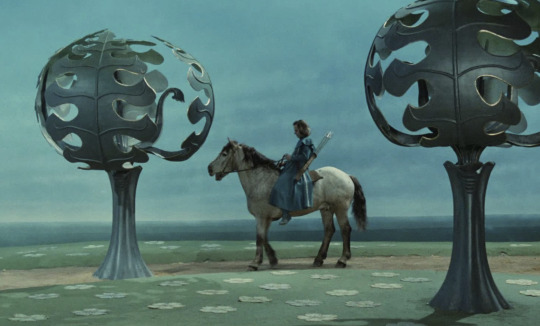
perceval le gallois 1978 has such kitschy surrealist teletubbies-esque visuals that it has nearly defeated me. i still haven't finished it. it's rare that a film feels like an assault on my eyeballs and yet i am compelled and i cannot look away
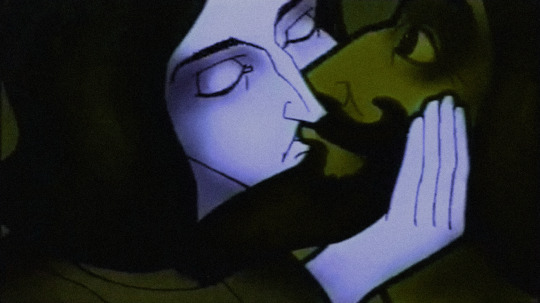
sir gawain and the green knight 2002 is a strangely horny stained glass animation that will give you motion sickness while saying bi rights over and over and over. it feels like a religious sunday cartoon. it won a bafta
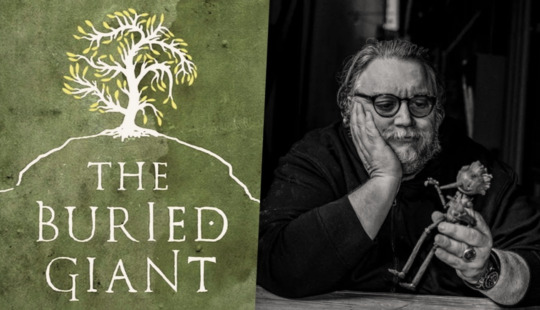
the buried giant – a beautifully atmospheric novel in its own right – is getting adapted into a stop motion film soon! i already know it will earn a spot on this list so consider this a place-holder
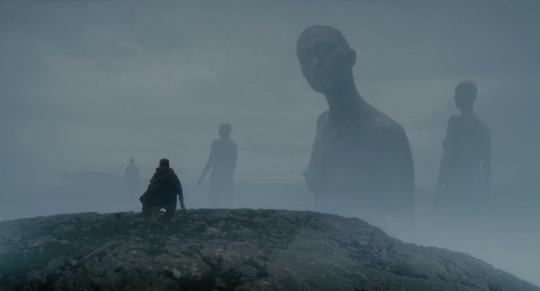
the green knight 2021 for the giants scene (and the 360-degree sequence of a tied-up gawain Losing The Game)
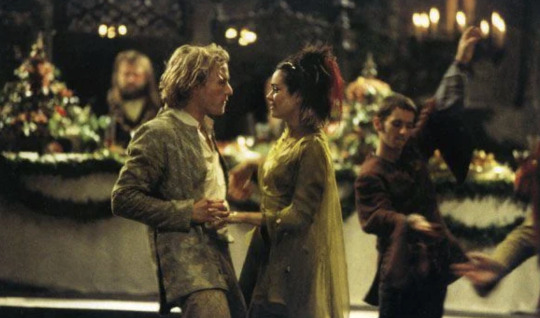
a knight's tale entirely because they dance to bowie's golden years
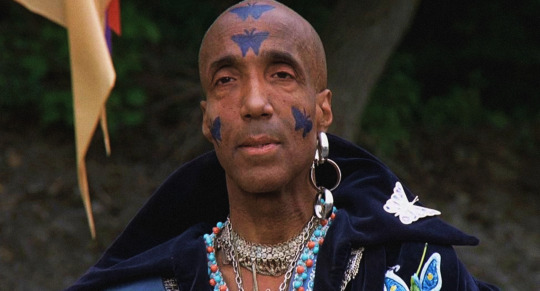
knightriders for the most charming merlin design i've ever seen and also for the whole knights jousting on motorbikes concept
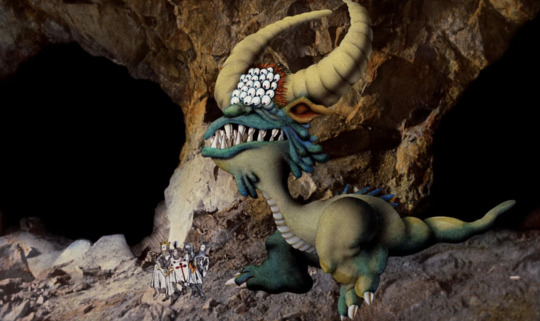
monty python and the holy grail for just about everything but above all else the bit where they're animated and then the animator abruptly dies of a heart attack and then they stop being animated
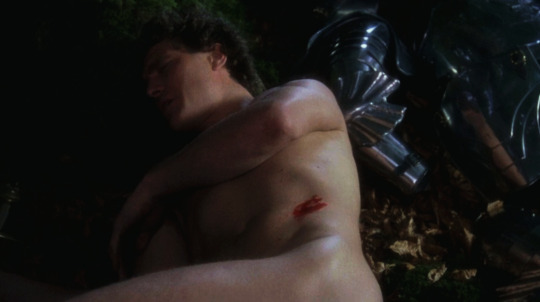
excalibur 1981 for everything as well but i cannot overstate the effect lancelot's dream where he wrestles his armor and homoerotically un-stabs himself had on me. i will never shut up about it
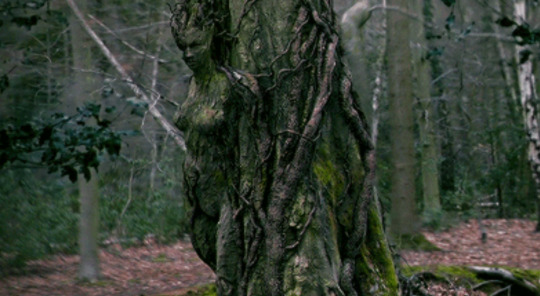
king arthur: legend of the sword just kidding i haven't seen this nor do i intend to. i'm just enamored with this 2-second shot of a tree girl and her tree titties and i think that everyone should witness her
#terry gilliam's fisher king almost made it on here but idk#its a better movie than some of these and i found it mostly-enjoyable and it simply didn't pass the nebulous yet specific vibe check#arthuriana#films#i was sooo tempted to add marika hackman's slime music video just to spread the gospel of lesbian knights wrestling & making out in the mud#but its ''not arthuriana'' or whatever (it is to me)
110 notes
·
View notes
Note
Man, I loved Alicole in S1. The courtly love aspect really drew me in and the potential of both characters, individually and separately, made me excited for S2...only for it to fall apart completely. I wasn't expecting it to be The Princess Bride or anything, but damn. It felt like ridicule and even with Criston's speech to Gwayne in the "finale", I can't even muster enjoyment because it's so hollow after what we got in S2. I know it's supposed to be a tragedy but their characters have been written so weirdly that I cringe every time I see a picture or gif of them together.
At university I studied courtly love (l'amour courtois) as it existed in medieval French literature. Because in medieval times marriage, especially among nobility, was a political and economic affair, love was viewed oftentimes separate from marriage. One manifestation of this is courtly love, described as an experience between erotic desire and spiritual attainment, "a love at once illicit and morally elevating, passionate and disciplined, humiliating and exalting, human and transcendent" (from The Meaning of Courtly Love).
Some suggest core tenets to courtly love: that the love is illegitimate, furtive, adulterous in nature; that the male lover holds an inferior position to the woman, who is often elevated in station; that the man completes quests, trials, challenges in his lady's name; that there are rules and subtleties to it, similar to chivalry or courtesy (from Études sur les romans de la Table Ronde). Devotion, piety, and gallantry were valued characteristics.
Many stories portray this love, like Tristan and Isolde and the tales of Lancelot and Guinevere, as well as songs, such as dawn songs, or albas / aubades, poems that spoke of lovers parting in the morning before rivals or spouses discovered them. One such song is Reis Glorios by the "master of troubadours" Giraut de Bornelh:
youtube
The potential for exploring courtly love in relation to the pairing of Alicent Hightower and the knight Ser Criston Cole is vast and could have been a fascinating expansion of the relationship between the two as it existed in Fire and Blood. Whether it resulted in a physically consummation of the love or existed as a romantic and spiritual devotion between a noble lady and her knight, there was so much that could have been explored: how does each view the other as the personification of chivalrous ideals of honor, duty, loyalty, piety? How do the rules of courtly love and its secret, private nature influence the interaction between these two? How does their courtly love influence their motivations and the actions they take in their journey? And, if physical, how might each view this in the context of their vows, responsibilities, and their ideals?
The least likely scenario of all of this, when it comes to this pairing, is a situation in which a decades-long mutual admiration somehow evolves / devolves into meaningless physical consummation of the relationship, especially considering not only the illicit nature of such an affair but also the ideals that both characters hold in relation to duty, honor, chivalry, and their own relationship to sex.
Yet once again this is the writers interpreting the story through a solely modern lens. With this tale, they focus on a solely physical experience in the context of Alicent finally "getting off" after being in a loveless marriage all her life, and its purpose is 1) to position her in contrast to the mourning of the main character ie "look how selfish and evil Alicent is, having sex with Rhaenyra's ex while Rhaenyra looks for her dead son" 2) portray her as hypocritical and paint the conflict between the two women as somehow solely the result of jealousy for sexual freedom / hypocrisy at hating sexually free women while wanting it / achieving it oneself (despite this clearly not being the crux of the issues between these two women) 3) set her up to be responsible for the death of her own grandson and lighten / distract the moment of Blood and Cheese with the purpose to mitigate the blame put upon the actual perpetrators by having them have sex during the sequence, pointing the blame at her and Cole for not preventing the act set in motion by the actual perpetrators, removing her role in the actual event as it was written in the source material.
By taking this stance of a solely physical, using each other for sex, modern lens of the relationship between the lady and her knight, it misses out on a more accurate exploration of what love and sex really looked like in a medieval setting. The story truly suffers for it, as do these characters. Instead of an exploration of feelings, motivations, or the development of this relationship across decades, it is reduced to a one dimensional plot device created solely to make the characters look worse in relation to others.
Unfortunately this pairing is not the only part of the show to suffer from this pattern. The result is the world and characters feel incomplete and hollow, divorced from the setting, the logic of the universe, and the humanity of these characters. Nowhere is the "human heart in conflict with itself" that GRRM explores with his characters and stories. And really, courtly love would have been a phenomenal way to build upon the themes GRRM loves to incorporate into his stories.
62 notes
·
View notes
Text



I'm starting to feel like how long my read lists are is revealing dangerous things about my psychological state, lmao. So yeah. still reading my body weight in manga and graphic novels. Sorry not sorry? Apparently, I read a whopping 66 books last month; four of them were novels. As usual, most of the graphic novels are from my local library, and most of the manga is from Libby. During March, I read:
Yona of the Dawn vol. 10 and 11 by Mizuho Kusanagi
Go with the Flow by Lily Williams and Karen Schneemann
The Summer With You: The Sequel by Nagisa Furuya
Mashle: Magic and Muscles vol. 1 by Hajime Komoto
Hitorijime My Hero vol. 5 to 8 by Memeco Arii
Stars of Chaos: Sha Po Lang vol. 5 by priest
Haikyu!! vol. 23 by Haruichi Furudate
Jujutsu Kaisen vol. 4 and 5 by Gege Akutami
I Hear the Sunspot by Yuki Fumino
The Missing Piece by Kun Yi Wei Lou
Spy x Family vol. 5 and 6 by Tatsuya Endo
I Hear the Sunspot: Theory of Happiness by Yuki Fumino
The Less Than Epic Adventures of TJ and Amal: Omnibus by E. K. Weaver
Go For It Again, Nakamura! by Syundei
How to Be a Werewolf vol. 1 by Shawn Lenore
Demon Slayer: Kimetsu no Yaiba vol. 13 and 14 by Koyoharu Gotouge
Dekoboko Sugar Days by Atsuko Yusen
Witch Hat Atelier vol. 1 by Kamome Shirahama
Cherry Magic! Thirty Years of Virginity Can Make You a Wizard?! vol. 5 to 8 by Yuu Toyota
Koimonogatari: Love Stories vol. 1 by Tohru Tagura
The Way of the Househusband vol. 1 and 2 by Kousuke Oono
Solo Leveling vol. 7 to 14 by Chugong
Bury Your Gays by Chuck Tingle
I Hear the Sunspot: Limit vol. 1 to 3 by Yuki Fumino
The Salt in the Sea by J. D. Rivers
Acid Town vol. 1 by Kyuugou
The Glass Scientists vol. 1 and 2 by S. H. Cotugno
Loved Circus by Nemui Asada
Snow Fairy by Tomo Serizawa
Bingo Love by Tee Franklin
I'm Looking for Serious Love! by Shoko Rakuta
Dekoboko Bittersweet Days by Atsuko Yusen
Dekoboko Sugar Days extras vol. 1 and 2 by Atsuko Yusen
Tristan and Lancelot: A Tale of Two Knights by James Persichetti
I Felt Myself Slipping by Ray Nadine
Global Examination vol. 1 by Mu Su Li
I Hear the Sunspot: Four Seasons vol. 1 and 2 by Yuki Fumino
Send Them a Farewell Gift for the Lost Time by Cocomi
A Complicated Omega's Second Love by Kichi Uekawa
Yagi the Bookshop Goat by Fumi Furukawa
A Kiss that Stains the Innocence by Emu Soutome
My Beautiful Man vol. 1 by Yuu Nagira
White Liar by Tomo Serizawa
23 notes
·
View notes
Text
William Morris' works (3)
We talked about "The Well at the World's End" in the previous post: here I want to talk about the second novel - sorry, romance - of Morris I know about. It is not one of his most famous pieces, but it is a very interesting and fascinating one: The Water of the Wondrous Isles.
It was part of the recent French translations that were published, and as with the last post I will info-mine the préface written for it, this time by William Blanc - and titled "The first feminist Arthurian romance".

Despite the old age of The Water of the Wondrous Isles - first published in 1897 by Kelmscott Press - it manages to be a very modern work, that predicted several evolutions of the fantasy genre nearly a century before they happened. Today it is culturally common to do a "feminine" or "feminist" version of the Arthurian myth (those two are not the same thing), in the wake of Marion Zimmer Bradley's very popular 1982 "The Mists of Avalon" which told the story of Camelot from the point of view of Morgan, reinvented as a great pagan priestess. You also find this with the bow-wielding Guinevere of Fuqua's 2004 "King Arthur" movie. But in a certain way, The Water of the Wondrous Isles did a "feminine Arthuriana" first.
William Morris, like the rest of Victorian society, was fascinated by the legends of the Round Table - he dedicated several of his youth productions to this myth. However unlike Alfred Tennyson, who was a poet adored by the upper-society of England and who liked to depict Camelot in a very misogynistic and conservative way, Morris was basically working for the "counter-culture" by making female characters his protagonists and his heroines. Already in his "Defence of Guinevere" (a verse work published in 1858) he depicted the queen of Camelot put on trial for her adulterous relationship with Lancelot: she offered a speech that turned the accusations on their head, to denounce the sordid institution of arranged marriages. For Morris, it is this tradition which is to be blamed, instead of the legitimate desire of women.
Forty years later, with his "Well at the World's End", Morris offers a variation of the quest for the Holy Grail, where a man and a woman quest as equals. H.G. Wells himself wrote about "The Well", in 1896, praising it for being a version of Malory's works where women are placed on the same rank as men. But what about "The Water of the Wondrous Isles"? A first obvious thing is that one of the main characters is called Arthur, and becomes the lover of the heroine Birdalone. Even better: after many adventures, he has a "madness episode" during which he flees to the depths of the wild forest for several years, almost turning into an animal. This is a common trope of the medieval tales of Camelot: a knight in love loses all reason because of his passion (see Tristan, Lancelot or Galehaut). But Morris, an admirer of the Arthurian myth, turns the tables and changes the tale so that his story corresponds to his political views and so that, more importantly, he can mock the Victorian sanitized versions of the Arthuriana. Here, it is not Lancelot or Tristan who becomes mad, it is rather a character with the name of the king of the Round Table - Morris has his "Arthur" wearing rags, wandering in the wilderness, not as a ruler but as a simple knight in love. So that Arthur takes on the role of the very man who, in the legends, seduced his wife. It is even more striking to notice that, in the medieval texts of the 13th or 15th centuries, once the knight is healed from his madness he returns into the warrior-aristocracy of their society. Within Morris works, such a "return to normal" never happens.

However, it is Morris' handling of female characters which requires a comparison with the Arthurian texts to fully understand his project.
The protagonist, Birdalone, is snatched away from her mother by a witch who turns her into a servant. She escapes by using a magical boat which allows her to cross the lake forming the titular "water of the wondrous isles". Yet, the boat is strange, because to work it requires the blood of its user to be spilled. This dangerous navigation, in which the heroine can lose her life, recalls another famous 19th century figure: the Arthurian poem of "The Lady of Shalott", by Alfred Tennyson (1832). To offer a brief recap, a young woman named Elaine of Astolat lives in a tower where she works on a tapestry. Seeing Lancelot by her window, she falls in love with him, abandons her weaving work, gets out of her tower, takes a boat leading her to Camelot, but dies as a result of her uncontrolable passion devouring her from the inside. Tennyson, with this tale, translates one of the fears of the Victorian patriarchy: to see women escape the domestic space in which they are confined, to see them express freely their desire. The poet warns maidens that such a behavior will lead to a harsh and horrible downfall (see 2000's "Myth and National Identity in Nineteenth Century Britain. The Legend of King Arthur and Robin Hood", Oxford University Press).
Tennyson's poem was fitting perfectly within the British society of the 19th century, and thus was illustrated many times. It was notably loved by the Pre-Raphaelite Confrery, which had many of its member later becoming friends of Morris: Elizabeth Siddal, in 1853, or Dante Gabriel Rossetti in 1857 both illustrated the poem. William Holman Hunt also made a drawing of Elaine in 1857, depicting her engulfed in her madness (symbolized by her disheveled hair, with the weaving of her tapestry mimicking a spider web). The colorized version of this drawing (1888-1905) is even more explicit: the young woman turns her back on a depiction of the Virgin Mary (see Jeffers Thomas' "Tennyson's Lady of Shalott and Pre-Raphaelites renderings: statement and counterstatements"). And of course, John William Waterhouse offered two different paintings of the tragic fate of Elaine, one in 1888 and one in 1894.

William Morris has this entire set of imagery in his head when he write "The Wondrous Isles", but he inverts it: the boat of Birdalone does not take her to her doom, but rather helps her escape imprisonment - she flees the domestic slavery in which the witch maintained her and lives various adventures. [In the text, Morris has the witch call Birdalone her "thrall", a term from the Old Norse society to designate a slave - the use of such an archaism is a manifestation of Morris' fascination for Old Norse texts]. To get out of the house is to encounter life, not death. In fact, we see here Morris criticizing the harsh conditions house-workers lived in as they toiled in the homes of upper-class Victorian families. When "The Water" was written, a third of the employed women were house-workers, and they were roughly in their twenties, just like Birdalone (see Davidoff Leonor's "Mastered for Life: Servant and Wife in Victorian and Edwardian England", and Theresa M.'s "The Domestic Revolution: The Modernization of Household Services in England and France 1820-1920").
Birdalone escaping through the boat is Morris' way to represent a woman free of the weight of the conservative Victorian society: she is free to go wherever she want, and to love whoever she wants. But these adventures have their dangers: throughout her journey she meets brutal men who, to possess her, threaten her and wound her - some even openly claiming they will rape her, such as the Red Knight. We find here a recurring theme in Morris' Arthurian texts, who is likely inspired by the murder of Morgause at the hands of her own son (who accuses her of adultery) in the medieval "Morte d'Arthur" ; he might also be influenced by the fate of Guinevere. Morris often depicts a masculine and patriarchal violence against women, but only to denounce them, such as through the trial of the queen of Camelot in "The Defence of Guinevere" ; or with the murder of the Sun Knight's wife in "The Well at the World's End" (the Sun Knight himself being a clear reference to Gawain).
But Morris doesn't depict the tragic condition of women as a fatality: on the contrary, his heroines fight back against the masculine aggression. Guinevere has her long defence-speech to denounce all those that condemn her relationship with Lancelot, Birdalone fights at first with a bow (a weapon commonly associated with women in Victorian England, as they practiced archery for sport), then wears an armor and uses a sword to attack and defend herself or her kin. Of course, Morris is still a man of his time, and so he depicts Birdalone easily outmatched every time she fights a man... But in this end of the 19th century, to have a woman fighting is a shocking thing. In the USA, one would have to wait forty more years before the fantasy pulps starting putting as main characters female warriors - such as C.L. Moore's Jirel of Joiry or Robert E. Howard's Dark Agnes.

Birdalone does not just go through her trials by fighting. As Florence Boos noted, the heroine of "The Water" uses the help and assistance of other women (Boss Florence, "The Socialist New Woman in William Morris' The Water of the Wondrous Isles): the three maidens, Aurea, Atra and Viridis, but first and foremost Habundia, the "Lady of the Wood" who helps Birdalone flee the house of the witch.
Habundia has a unique place within the text: associated with magic and the forest while clearly not being part of the human species, she reminds of another famous Arthurian woman at the time: Viviane. Just like with the Lady of Shalott, Tennyson gave Viviane a bad name in his poems. In his "Idylls of the King" (1859), he depicts Vivien as the one who trapped Merlin with her spells, in the heart of the forest, to steal his powers before locking him inside an oak-tree. We find back this fear of the Victorian patriarchy that is the "fallen woman", the "prostitute, the temptress, the archetype of the woman who, just likes Eve, drags men to their downfall (see Auerbach Nina's "Woman and the Demon: The Life of a Victorian Myth"). Like in medieval literature, the male doom is tied to the forest, perceived as a wild and dangerous space. In Gustave Doré's engravings for Tennyson's Vivien, we see Merlin as a very old man trapped between the young seductress and a tree whose roots wrap themselves around the couple.
Morris rejects this imagery: just like with Elaine or Guinevere, he inverts the tradition. Habundia offers a positive Vivien: with her, the forest and magic are not perdition, but salvation. Inverting Tennyson's discourse is not just a way for Morris to oppose himself to the famous conservative poet ; it rather takes place in a larger political context. Ever since hs youth, Morris has been influenced by the progressist Romantics. In the early 1880s, he engaged himslf in socialist revolutionnary movements: in 1883 he joined the Democratic Federation of Henry Hyndman, before co-founding at the end of 1884 the Socialist League and becoming the chief redactor of its newspaper, "Commonweal", to which participated Paul Aveline and Eleanor Marx (daughter of Karl Marx). While they mostly focused on questions of "classes", they still formed a thought about the life conditions of women, and denounced the bourgeois patriarchy. In 1885, they published the English translation of August Bebel's 1879 Woman and Socialism (Bebel was one of the leading figures of the German socialist movement). Simultaneously, a scandal erupted when William Thomas Stead published an investigation about child prostitution. All of this pushed Eleanor Marx to write with Paul Aveline, in 1887 "The Woman Question" (see Kapp Yvonne's "Eleanor Marx, a biography"). One year later, Morris and other members of the Socialist League supported the strike of female workers in the match-making factories of London (see Taylor Rosemary's "The city of dreadful delight: William Morris in the East End of London").
The institution of marriage is the focus of the socialist critique against women's life-conditions in Victorian society. The manifesto of the Socialist League, published in the first issue of "Commonweal" and cosigned by Morris and Eleanor Marx, compares marriage to prostitution. Eleanor Marx goes further in september 1885 by claiming that the sexual exploitation of women is the same as the salarial exploitation of capitalism. All of this transpires in the fate that the witch prepares for Birdalone: she is born from a poor family, her body is entirely offered to her new "mistress", and said mistress not only uses the girl for manual work, but also plans during her teenagehood to prostitute her. A passage of "The Water" seems to take back the same comparison Eleanor Marx makes between domestic work and prostitution.
In front of all this, Birdalone does not find a solution in the protection of a male figure: rather, she emancipates herself through her own work, notably her mastery of embroidery. The witch wants her to use this art to better seduce men, but Birdalone transforms it into a tool to gain her freedom.

"The Water of the Wondrous Isles" prefigures several motifs that shall become central in 20th and 21st century fantasy, but it also depicts something original for fantasy: a fantasy world where a lot of focus is given to crafts and the artisanal world ; something quite unusual in an epic genre that often ignores handwork.
Morris is a socialist, but also a heir of John Ruskin, who opposed the alienation of the 19th century factory-worker, used in a chain-work to reproduce endlessly the same calibrated ugly objects, to the (very idealized) freedom of the medieval craftsman, able to be autonomous in his work and to create unique (and thus beautiful) items. Morris put this thought in practice: all throughout his life, he interested himself in the "decorative arts", creating furnitures, wallpapers, staine glass and tapestries. He founded his very own society, Morris and co., in 1861, and thirty years later he opened his own publishing house, Kelmscott Press, in which he tried to create books imitating medieval manuscripts. Morris does not separate craftsmanship from his literary productions, the two are linked: the beautiful book is a box containing the beautiful text, and together they form a prolongation of his political engagement, an answer to the ugliness produced by the industrial capitalism.
In "The Water of the Wondrous Isles" Birdalone embodies this political valorization of labor. Her goal in life is not to marry a beautiful prince or to have children, but to become autonomous through her work. An entire part of the book depicts her leaving her friends to work with her own hands in the City of the Five Crafts. This industrious community evokes the descriptions Tolkien would write sixty years later of the Shire, in The Lord of the Rings (Tolkien was five when "The Water of the Wondrous Isles" was published) ; but whereas Tolkien's creation is a small countryside society, Morris presents an entire city where the handwork is not decorum but rather the heart of the action: when she arrives, Birdalone proves her talent and is quickly accepted by a local guild. She later creates her own workshop, and for five years she wlecomes numerous women in it, before leaving and offering her business to her coworkers. This reminds us of the activities of Morris, with his "Morris and co." and "Kelmscott Press" ; it also reminds us of the "socialist future" imagined by Morris, a future in which the guild system of the Middle-Ages returned, to oppose the capitalist exploitation (this idea of the future is what later gave birth in the British Left to the "Guild Socialism").
The sejourn of Birdalone in the City of the Five Crafts, which forms the introduction of the sixth part of "The Water", is not just an aside: it is a central element, because Morris shifts again a traditional motif. The one of Cinderella: in the version that the brothers Grimm popularized and that Morris is aware of (he asked Edward Burne-Jones in 1864 to make ceramic ornaments depicting the Grimm's Sleeping Beauty and Cinderella), Cinderella, a girl from a modest background, marries a prince. Morris' similarly humble heroine meets the beautiful knight Arthur, but their relationship does not elevate Birdalone in society. On the contrary, Arthur and her leave the castle and settle themselves in the birth-town of the young woman, governed by a council. Here, Arthur becomes part of this tiny republic, earning a role that Morris explicitely compares to a Roman consul. Meanwhile Robert, a former employee of Birdalone who worked with her at the City of Five Crafts, marries Aurea, a noble friend of Arthur. The tale ends in a hamlet of craftsworkers where the frontiers between the classes are broken: only remains a community of free workers, the medieval town becoming an allegory of the future socialism.

The political fight of Morris is mixed with a fascination for, and an idealization of, the Middle-Ages. His vision mixes progressist hope and a nostalgia for a lost era. He explored it in his 1890's utopia, "News from Nowhere", and we find it here through the character of Habundia. Unlike the other companions of Birdalone, at the end of the story she does not live within the city, but in the nearby forest. She does not embody Middle-Ages of guilds, but rather the Middle-Ages which are (ever since the 18th century) associated with an idealized nature, the druids, the fairies and the elves. The Lady of the Wood is "not from the race of Adam", she is not a human being, but she is far wiser than humans and owns an ancient knowledge that she describes as a "great book of nature", a knowledge that she transmits to Birdalone.
We find here a typical motif of fantasy: the "wise one" from a non-human race who lives in an ancient forest. It is Galadriel, from The Lord of the Rings, it is Yoda from The Empire Strikes Back. Morris doesn't invent this motif: it already existed at the end of the 14th century, in Chaucer's "Tales of Canterbury", within the story of The Wife of Bath. Taking place in Arthurian times, the texts opens with a description of the Queen of the Elves dancing merrily with her subject, before holy Churchmen banish them away. Morris knows this text, and Kelmscott Press published in 1896 a beautiful edition of the Tales of Canterbury, illustrated by Edward Burne Jones (in general, many echoes of The Wife of Bath's Tale can be found within The Water of the Wondrous Isles). But whereas Chaucer rejoices in the disappearance of the elves, Morris regrets them. This nostalgia, which will be found again in Tolkien's works, is a new thing for the Victorian era, and it translates a new fear: the one of seeing nature disappear because of industrialization. Morris interwoves this with a political thought: at the end of the 19th century it was a common thing to believe, in socialist circles, that many pre-industrial ancient societies were organized in a communist way. This "proto-communism" was explained by the fact these ancient societies were supposedly dominated by women, a trait thought to have survived in the Norse and Germanic societies of early Middle-Ages but that disappeared with the apparition of "private property", which imposed a patriarchal power.
This idea, originally created by Friedrich Engels in his 1884's The Origin of the Family, Private Property and the State, heavily influenced Morris. (See Boos Florence's "Gender-Division and Political Allegory in the Last Romances of William Morris", and Eller Cynthia's "Gentlemen and the Amazons: The Myth of Matriarchal Prehistory") This imagery, which was a very idealized version of the past, fully played in the creation of Habundia. She embodies the perfect "original past", a past without economical property, without social property, without sexual property. If we admit that the city where the adventures end symbolizes an utopia, a prefiguration of socialism, the last pages of "The Water" allow an idealized past to neighbor a desired future: the primitive-communism of Habundia and the democratic city of the free craftsmen. Between the two is a nightmarish aside, the one of the industrial and patriarchal capitalism, in which the reader lives, and expressed through the character of the witch, who took Birdalone from her mother, abused her, and is never forgotten.

#the water of the wondrous isles#william morris#fantasy literature#pre-tolkien fantasy#fantasy book#fantasy archetype#political fantasy
21 notes
·
View notes
Text
Literature recommendations for the coming days (Pt 93)










Monstrous: A Transracial Adoption Story - Sarah Myer
The Well - Jake Wyatt and Choo
Taproot: A Story About a Gardener and a Ghost - Keezy Young
The Marble Queen - Anna Kopp & Gabrielle Kari
Tragic: (Vol. 1-2) - Dana Mele, Valentina Pinti, and Chiara Di Francia
Coven: A Graphic Novel - Jennifer Dugan & Kit Seaton
The Deep Dark - Molly Knox Ostertag
Tristan & Lancelot: A Tale of Two Knights (An Arthurian Love Story) - James Perischetti & L.S. Biehler
Are You Listening? - Tillie Walden
16 notes
·
View notes
Text



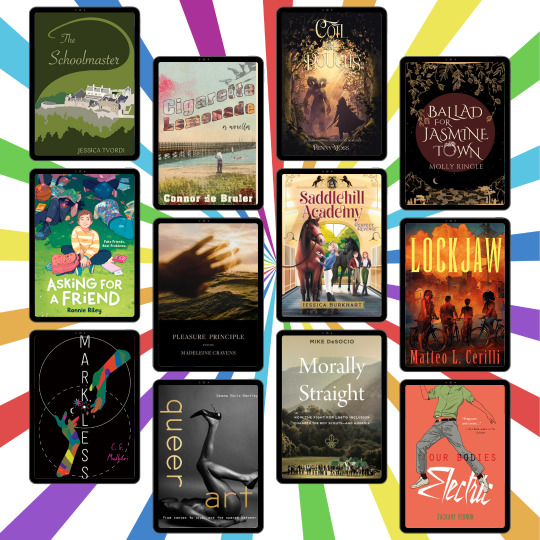
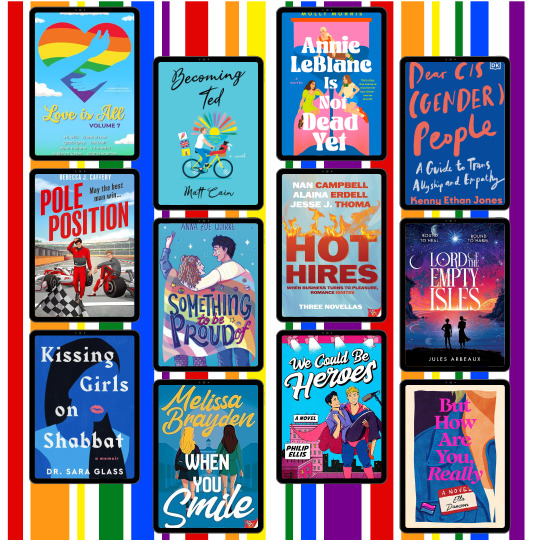

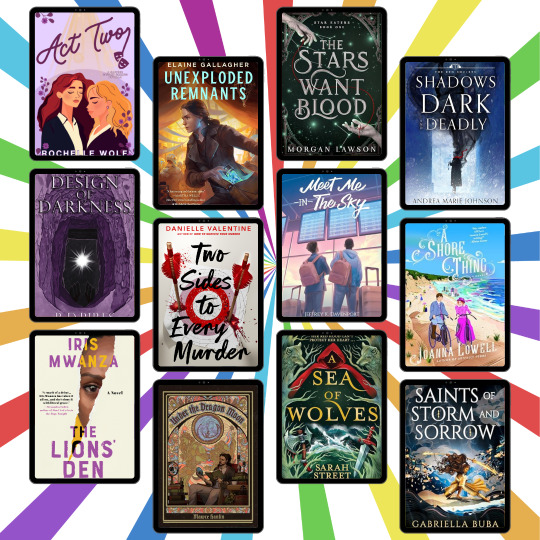


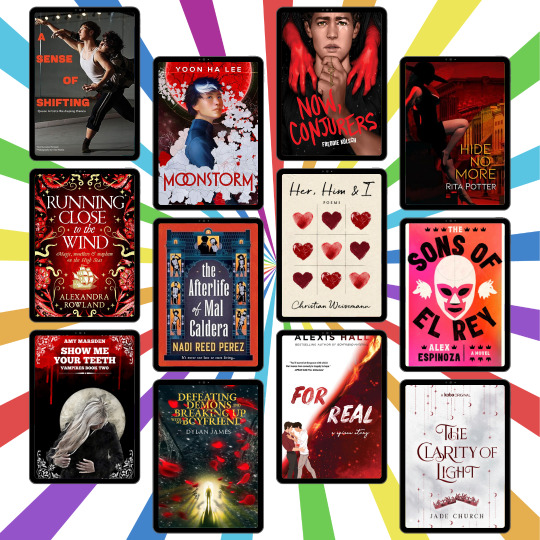
🌈 Queer Books Coming Out in June 2024 🌈
🌈 Good morning, my bookish bats, and happy Pride Month!! Struggling to keep up with all the amazing queer books coming out this month? Here are a FEW of the stunning, diverse queer books you can add to your TBR before the year is over. Remember to #readqueerallyear! Happy reading!
[ Release dates may have changed. ]
❤️ The Shadow of Summer - Marlon Yelich 🧡 Of Stardust - (ed) Avrah C. Baren 💛 The Ballad of Jacquotte Delahaye - Briony Cameron 💚 Triple Sec - T.J. Alexander 💙 Same Difference - E.J. Copperman 💜 The Pull of the Tide - Various ❤️ The Misadventures of Getting Lainey a Date - Eija Jimenez 🧡 Surface Pressure - Adrian J. Smith & Neen Cohen 💛 Mirrored Heavens - Rebecca Roanhorse 💙 The Fire Within Them - Matthew Ward 💜 One and Done - Frederick Smith 🌈 Digging for Destiny - Jenna Jarvis
❤️ She Who Brought the Storm - Vaela Denarr & Micah Iannandrea 🧡 Tristan and Lancelot: A Tale of Two Knights - James Persichetti & L.S. Biehler 💛 London on My Mind - Clara Alves (translated by Nina Perrotta) 💚 The Deep Dark - Molly Knox Ostertag 💙 Furious - Jamie Pacton & Rebecca Podos 💜 Gay the Pray Away - Natalie Naudus ❤️ Such A Small World - Jordan Clayden-Lewis 🧡 Make It Count: My Fight to Become the First Transgender Olympic Runner - CeCé Telfer 💛 Cicada Summer - Erica McKeen 💙 We Used to Live Here - Marcus Kliewer 💜 Dandelion - Merlina Garance 🌈 The Curse of the Goddess - C.C. González
❤️ The Schoolmaster - Jessica Tvordi 🧡 Cigarette Lemonade - Connor de Bruler 💛 Coil of Boughs - Penny Moss 💚 Ballad for Jasmine Town - Molly Ringle 💙 Asking for a Friend - Ronnie Riley 💜 Pleasure Principle - Madeleine Cravens ❤️ Perfect Revenge - Jessica Burkhart 🧡 Lockjaw - Matteo L. Cerilli 💛 Markless - C.G. Malburi 💙 Queer Art - Gemma Rolls-Bentley 💜 Morally Straight - Mike De Socio 🌈 Our Bodies Electric - Zackary Vernon
❤️ Love Is All - Various 🧡 Becoming Ted - Matt Cain 💛 Annie LeBlanc Is Not Dead Yet - Molly Morris 💚 Dear Cisgender People: A Guide to Trans Allyship and Empathy - Kenny Ethan Jones 💙 Pole Position - Rebecca J. Caffery 💜 Something to be Proud Of - Anna Zoe Quirke ❤️ Hot Hires - Nan Campbell, Alaina Erdell, Jesse J. Thoma 🧡 Lord of the Empty Isles - Jules Arbeaux 💛 Kissing Girls on Shabbat - Sara Glass 💙 When You Smile - Melissa Brayden 💜 We Could Be Heroes - Philip Ellis 🌈 But How Are You, Really - Ella Dawson
❤️ A Bluestocking's Guide to Decadence - Jess Everlee 🧡 Take All of Us - Natalie Leif 💛 One Killer Problem - Justine Pucella Winans 💚 Why Are People Into That? - Tina Horn 💙 Free to Be: Understanding Kids & Gender Identity - Jack Turban 💜 Lady Eve's Last Con - Rebecca Fraimow ❤️ Sea of Broken Glass - Jenna Pine 🧡 Rapunzella, Or, Don't Touch My Hair - Ella McLeod 💛 Wolfpitch - Balazs Lorinczi 💙 Looking for a Sign - Susie Dumond 💜 Director's Cut - Carlyn Greenwald 🌈 Wish You Weren't Here - Erin Baldwin
❤️ Act Two - Rochelle Wolf 🧡 Unexploded Remnants - Elaine Gallagher 💛 The Stars Want Blood - Morgan Lawson 💚 Shadows Dark and Deadly - Andrea Marie Johnson 💙 Design of Darkness - R.D. Pires 💜 Two Sides to Every Murder - Danielle Valentine ❤️ Meet Me in the Sky - Jeffrey K. Davenport 🧡 A Shore Thing - Joanna Lowell 💛 The Lions' Den - Iris Mwanza 💙 Under the Dragon Moon - Mawce Hanlin 💜 A Sea of Wolves - Sarah Street 🌈 Saints of Storm and Sorrow - Gabriella Buba
❤️ Private Rites - Julia Armfield 🧡 Everyone I Kissed Since You Got Famous - Mae Marvel 💛 The Stars Too Fondly - Emily Hamilton 💚 Keeping Carmen Ruiz - Alyson Root 💙 Cuckoo - Gretchen Felker-Martin 💜 Heartwaves - Anita Kelly ❤️ Bound to the Wild Fae - Tavia Lark 🧡 Four Squares - Bobby Finger 💛 The Ghost of Us - James L. Sutter 💙 Poison in Their Hearts - Laura Sebastian 💜 Puppy Love - Elle Sprinkle 🌈 Hot Summer - Elle Everhart
❤️ Liddy-Jean Marketing Queen and the Matchmaking Scheme - Mari SanGiovanni 🧡 All Friends Are Necessary - Tomas Moniz 💛 Six of Sorrow - Amanda Linsmeier 💚 Shanghai Murder - Jessie Chandler 💙 PROUD - Anthology 💜 Little Rot - Akwaeke Emezi ❤️ Fling - Deja Elise 🧡 Too Many Stars to Count - Frances M. Thompson 💛 Rakesfall - Vajra Chandrasekera 💙 The Unrelenting Earth - Kritika H. Rao 💜 Freakslaw - Jane Flett 🌈 Please Stop Trying to Leave Me - Alana Saab
❤️ A Sense of Shifting - Coco Romack, Yael Malka 🧡 Moonstorm - Yoon Ha Lee 💛 Now, Conjurers - Freddie Kölsch 💚 Hide No More - Rita Potter 💙 Running Close to the Wind - Alexandra Rowland 💜 The Afterlife of Mal Caldera - Nadi Reed Perez ❤️ Her, Him & I - Christian Weissmann 🧡 The Sons of El Rey - Alex Espinoza 💛 Show Me Your Teeth - Amy Marsden 💙 Defeating Demons and Breaking Up With My Boyfriend - Dylan James 💜 For Real - Alexis Hall 🌈 The Clarity of Light - Jade Church
#queer books#queer#pride#pride month#sapphic books#sapphic romance#gay#gay romance#gay books#gay pride#wlw romance#wlw#wlw fiction#lesbian romance#lesbian pride#lesbian books#lesbian fiction#lesbian#bisexual romance#bisexual visibility#bisexual pride#bisexuality#bi books#book releases#book release#batty about books#battyaboutbooks#books
33 notes
·
View notes
Note
Some additions for your list of everything from my collection of pre-2020 modern retellings.
Mordred’s Curse (1996) and Merlin’s Gift (1997) by Ian McDowell, both Mordred’s pov. Haven’t finished reading them, but they’re interesting takes. Retains Monmoth’s casting of Mordred as the Queen’s lover.
The Green Knight (1975) by Vera Chapman. Alternates between Vivian and Gawain’s pov. Also have not finished reading.
Fang the Gnome (1988) by Michael Greatrex Coney. Takes a while for the Arthurian content to get underway, but Nyneve, human apprentice to the sorceress Avalona, eventually conjures up the world of Camelot. Major appearance by Tristan. Also includes Torre, Melin, Marhaus (Morholt), Palomides, Iseult, Arthur, Morgawse, Gawain, Galahad, and others I’m probably forgetting.
King and Raven (1995) by Cary James. OC Micah navigates the court of Camelot, ascending from fugitive to knight while bearing witness to the legend of Arthur.
Hawk of May (1980), Kingdom of Summer (1981), and In Winter’s Shadow (1982) by Gillian Bradshaw (Series title: Down the Long Wind). Makes the unusual choice of casting Bedwyr in the place of Lancelot as Gwynhwyfar’s lover.
Sword of the Valiant (1984) by Stephen Weeks and Henry Whittington. Inspiration for the Sean Connery Green Knight movie
In Camelot’s Shadow (2004) by Sarah Zettel. OC/Gawain adventure romance
Merlin’s Mirror (1975) by Andre Norton, sci-fi re-incarnation Arthurian tale
Sweet Black Waves (2018) by Kristina Pérez. YA Tristan and Isolde retold from the perspective of Branwen (Brenganae) first in a trilogy but I don’t know if the other two are Arthurian-related.
The Buried Giant (2015) by Kazuo Ishiguro. Haunting piece set in the post-Arthurian dark age Britain. Gawain makes an extended appearance towards the end.
Thank you so much!! Most of these are in the list but I will add the three missing ones!
Sword of the Valiant (1984) Sweet Black Waves (2018) The Buried Giant (2015)
I will tag this with "to add" so I will remember :D
13 notes
·
View notes
Text

May has been a bit of a wild card. I picked up a book that I hadn’t planned to read this month that ended up being one of my favorite books of the year, had a DNF, and in general just had a chaotic reading month. So, here’s what I read:
Halo 5⭐️ {review}
Pretty Boy 4⭐️ {review}
Mixed Signals 4⭐️
A Spell For Heartsickness 4⭐️ {review}
Fox-Colored Jealousy 5⭐️ {review}
Forbidden Titan 4.5⭐️ {review}
Free From Falling 5⭐️ {review}
Tristan & Lancelot: A Tale Of Two Knights 3.5/3.75⭐️ {review}
Rosaline Palmer Takes The Cake DNF @30 pages
Captivating 4.5⭐️ {review}
Shatterglass -currently reading
Switch-Hitter -currently reading
My favorite book this month was Free From Falling! I hadn’t planned to read it this month, but it was calling my name from the shelf and I just had to read it. It was such a wonderful book and it’s one of my top favorites of the year!
#booklr#may wrap up#books#reading#queer books#lgbtq+ books#read#bookish#bookworm#halo#pretty boy#mixed signals#the beginning of always series#a spell for heartsickness#the rune tithe series#fox colored jealousy#forbidden titan#north shore titans series#fre from falling#breakaway series#Tristan and Lancelot: a tale of two knights#a tale of two knights#Rosaline Palmer takes the cake#captivating#elite protection services series#shatterglass#circle of magic#the circle opens#switch-hitter#hit and run series
1 note
·
View note
Text
It's Friday, y'all! Pass the yaoi!




2 notes
·
View notes
Text























NEW YOUNG ADULT RELEASES! (JUNE 4TH, 2024)
___
HAVE I MISSED ANY NEW YOUNG ADULT RELEASES? HAVE YOU ADDED ANY OF THESE BOOKS TO YOUR TBR? LET ME KNOW!
___
NEW STANDALONES/FIRST IN A SERIES:
Annie LeBlanc is Not Dead Yet by Molly Morris
Four Eids and a Funeral by Faridah Àbíké-Íyímídé & Adiba Jaigirdar
Heiress Takes All by Emily Wibberley & Austin Siegemund-Broka
Moonstorm by Yoon Ha Lee
Wish You Weren't Here by Erin Baldwin
Two Sides to Every Murder by Danielle Valentine
One Killer Problem by Justine Pucella Winans
The Breakup Artists by Adriana Mather
Take All of Us by Natalie Leif
Louder Than Words by Ashley Woodfolk & Lexi Underwood
Tristan and Lancelot: A Tale of Two Knights by James Persichetti & L.S. Biehler (Illustrator)
Markless by C.G. Malburi
Furious by Jamie Pacton & Rebecca Podos
An Outbreak of Witchcraft by Deborah Noyes & Melissa Duffy (Contributor)
Storm: Dawn of a Goddess by Tiffany D. Jackson
Now, Conjurers by Freddie Kölsch
Looking for Smoke by K.A. Cobell
Lady of Steel and Straw by Erica Ivy Rodgers
Spilled Ink by Nadia Hashimi
If You Can't Take the Heat by Michael Ruhlman
Lockjaw by Matteo L. Cerilli
London on My Mind by Clara Alves & Nina Perrotta (Translator)
What's Murder Between Friends by Meg Gatland-Veness
NEW SEQUELS:
Past Present Future (Rowan & Neil #2) by Rachel Lynn Solomon
___
Happy reading!
#New Releases#New Books#tbr#to-read#young adult#YALit#Yareads#June 2024#Rachel Lynn Solomon#Meg Gatland-Veness#Clara Alves#Nina Perrotta#Matteo L. Cerilli#Michael Ruhlman#Nadia Hashimi#Erica Ivy Rodgers#K.A. Cobell#Freddie Kölsch#Tiffany D. Jackson#Deborah Noyes#Melissa Duffy#Jamie Pacton#Rebecca Podos#C.G. Malburi#James Persichetti#L.S. Biehler#Ashley Woodfolk#Lexi Underwood#Natalie Leif#Adriana Mather
20 notes
·
View notes
Note
Fun fact please?
Underappreciated characters are a thing tonight so Today You Learned about Sir Dinadan!
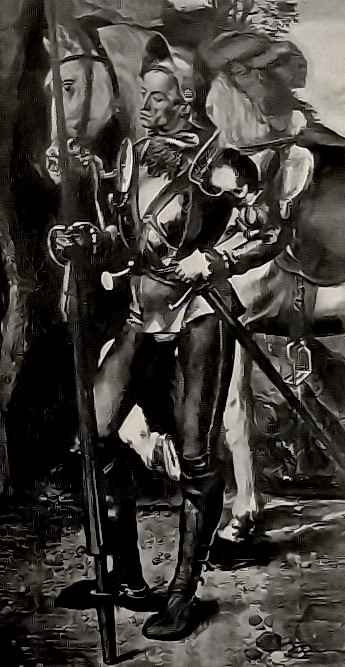
In King Arthur stories there’s a butt-ton of random characters, including over a hundred knights of the Round Table. And among them is Sir Dinadan, first attested in one of the versions of the Sir Tristan story. He’s the son of Sir Bruenor Senior, and his brothers Sir Bruenor Jr. and Daniel are also knights. What makes Sir Dinadan stand out from other knights is that A) his sense of humor and B) despite his bravery and own skill with a sword, he actually prefers to avoid both fighting and that whole courtly love nonsense.
[Courtly Love, if you don’t know, is this popular idea in medieval romances of knights falling in love with an unattainable woman. Lancelot and Guinevere is the example usually trotted out for this.]
This sounds like common sense if you ask me, but it was incredibly uncommon among Arthur’s knights! They loved to get into fights to prove their worth and fall in love with women they couldn’t easily be with. But not Dinadan: he was just not into that crap. He was more of a wise guy–he liked pulling jokes, telling jokes, and being the butt of jokes. Much better than getting whaled on by other knights. He was also incredibly clever in other ways, such as being able to tell who the other knights are in full armor even if they’re not wearing their coat of arms–again, a really useful trait, considering how often it happens in Arthurian stories.
Sadly, despite being an all-around nice guy, in Mallory’s Le Morte d’Arthur, he’s friends with Sir Lamorak, which gets him on the hit list of the Orkneys (there’s a feud between the sons of Lot of Orkney and Lamorak’s family). When he’s on the way back home, wounded from a fight, Dinadan is jumped by Agravaine and Mordred, and they murder him. He gets back home with enough time to drop dead in Lancelot’s arms.
That’s rough buddy.
Because he’s not really a key part in the more popular stories, he’s left out of most adaptations, and if he appears at all it’s basically a named extra, like this one number in Camelot. Dinadan does get a wonderful story in Gerald Morris’s Squire’s Tales series, featured as the title character in The Ballad of Sir Dinadan. That one changes his backstory into being Sir Tristan’s brother, explaining why he hangs out with him at all, and spends the entire novel lampshading how stupid Tristan and Isolde are being. It’s brilliant. He’s also brought back in the last two books of the series despite not doing much because he was such a fun and popular character in the series.
So Dinadan! Show him some appreciation.
32 notes
·
View notes
Note
Hello. I shall thank you again for replying to my requests, which are really helpful. But there is a question that I would love to ask. Or maybe two
1. What are your personal favourite Arthuriana movies/series?
2. Which Arthuriana movies/series are the most accurate to the Legends?
3. Which ones shall I avoid? And why?
P. S. I have already watched:
Knights of the Round Table (1953) 9/10 (I loved Lancelot and Elaine together. He loved her, just not as much as he loved Guinevere... Arthur/Lancelot chemistry. Lancelot vs Mordred... Unexpected duel)
Lancelot du Lac (1974) 7/10 (I loved Gawain and the relationship with Lancelot)
Excalibur (1981) 10/10 (The movie is a gem. I wish we had more like this nowadays... The Lancelot redemption was amazing)
Cursed (2020) 6/10 (I only liked the Fae lore there)
BBC Merlin 8/10 (There were some wack moments. And Arthur wasn't really my jam. But the show is amazing)
hi! you’re welcome, i’m glad it was helpful. :^)
this is going to be a long multi-part answer, so i’ll throw it below a cut to avoid an obnoxious wall of text on the dash.
1. What are your personal favourite Arthuriana movies/series?
movies:
Knights of The Round Table (1953)
Sword of Lancelot (1963)
Camelot (1967)
Lancelot du Lac (1974)
Monty Python and The Holy Grail (1975)
Excalibur (1981) [review]
Merlin and The Sword (1985)
A Knight’s Tale (2001)
Tristan and Isolde (2006)
Kaamelott First Installment (2021)
The Green Knight (2021)
shows:
The Adventures of Sir Lancelot (1956–1957)
BBC The Legend of King Arthur (1979)
Merlin (1998)
Starz Camelot (2011)
2. Which Arthuriana movies/series are the most accurate to the Legends?
finding an “accurate” arthurian adaptation or retelling is an exercise in futility. no iteration exists without its own unique interpretation, including the medieval texts. gawain is obscenely inconsistent, so determining what constitutes an “accurate” characterization of him is literally impossible. the same can be said for every aspect of the legends. each author does their own thing! the other problem is that even if what’s there is reminiscent of the stories it references, something is inevitably missing. most of the time it’s gaheris. (okay, it’s always gaheris.) more often than not, the entire prose tristan cast gets cut. occasionally, one of the lads will show up on his own completely disconnected from the original lore… (palamedes in the black knight (1954), lamorak in sword of lancelot (1963) and again in kaamelott the first installment (2021), dinadan in camelot (1967), and tristan in king arthur (2004)) but i digress. if you’re looking for something that covers the majority of the story from arthur’s conception to his death, the choices are minimal.
BBC The Legend of King Arthur (1979)
Excalibur (1981)
3. Which ones shall I avoid? And why?
movies:
The Black Knight (1954): orientalist, black face palamedes. enough said.
Sword of The Valiant (1984): a remake of gawain and the green knight (1973) with worse everything from casting to costuming to pacing. tall, jacked gawain isn’t real and can’t hurt me.
Guinevere (1994): if i was persia woolley and they showed me this movie calling it an adaptation of my books, i’d maul them.
First Knight (1995): so ick it’s funny. wow this lancelot sucks. american accent, insufferable, entitled, gives face-hugger kisses? convoluted scenarios presented as romantic. lame costuming. questionable age gap between arthur/guin. he knew her as a child????? girl run.
Quest For Camelot (1998): rip author vera chapman, fortunate enough to pass before witnessing this abominable adaptation. why americanize the names lynette and gareth? why the hideous animation? the shabby song and dance numbers? the books are dark let’s make a kids musical out of it!
King Arthur: Legend of The Sword (2017): weaksauce attempt to cash in on existing audience. discombobulated the lore until unrecognizable. two women are fridged in the first half hour. strangely edited. nobody is likable. overall cringe.
shows:
King Arthur and The Knights of Justice (1992): nothing of substance here, typical 90s cartoon existing to sell toys.
The Mists of Avalon (2001): i’ll never support anything related to author marion zimmer bradley. she’s dead, let’s kill her legacy too.
Merlin’s Apprentice (2006): not sure what happened here but this sequel to the 1998 original is the biggest downgrade ever.
The Seven Deadly Sins (2014–present): every pitfall an anime can have, this one has in spades. beyond the bastardization of arthurian lore, it’s hard to follow chronologically bc the seasons are named not numbered, full of shameless fan service, lolis, a drop in budget resulted in ugly cgi animation.
Netflix Cursed (2020): take a shot every time a nicknamed character is revealed to be loosely arthurian. no don’t you’ll get alcohol poisoning. did netflix do it? did they solve misogyny by putting a sword in a girl’s hand? this was so disappointing it offended me.
anyway if there’s something i didn’t mention here then it’s mid. bbc merlin isn’t really my thing but it’s fun! transformers feels so far removed from actual arthuriana it’s not worth discussion, unlike some others that are trying really hard and suck so much. stuff like that. hope this gives you some things to check out next!
10 notes
·
View notes